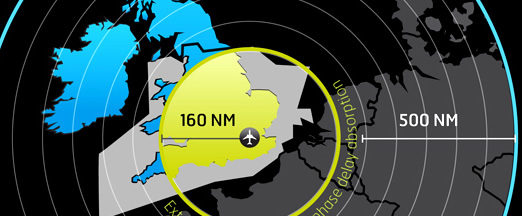One of the main things occupying the minds of those involved in providing air traffic services is how we reduce costs for airlines whilst improving safety and reducing emissions.
One way of doing this is to develop new technologies and concepts – and that’s the aim of SESAR, the Single European Sky ATM Research programme. SESAR is the technology pillar of the European Commission’s Single European Sky initiative to modernise Europe’s air traffic management systems.
We’ve taken a very active role in SESAR and are leading a Work Package looking at the technologies and concepts required to help reduce costs and cut emissions in Terminal Operations. One really exciting aspect of this involves how the latest technologies can help us manage arrivals into airports so as to reduce holding, reduce fuel burn and emissions and, in doing so, reduce costs.
I was invited to give a presentation on this topic recently at a special event organised by the Delegation of the European Union to the United States and the SESAR Joint Undertaking – part of an ongoing programme of activities designed to strengthen the relationship between the EU and US on critical issues.

Adrian speaking at the special event in Washington DC organised by the Delegation of the European Union to the United States and the SESAR Joint Undertaking.
I spoke about our work on reducing aircraft holding at Heathrow by slowing streams of arriving aircraft when delay is anticipated – a concept known as extended arrival management. Reducing holding by slowing aircraft down en route reduces the need for aircraft to hold close to an airport, circling, burning extra fuel and generating more emissions.
We’ve created a simple infographic to help explain the idea behind extended arrival management. Click on the thumbnail below to view it at a larger size in your browser window (you can also download a pdf version here).

Click to enlarge (then click again in the top left of that version when it opens in a new browser window. This will display a full size version which you can then scroll left and right to read and view.)
An important part of this concept is to ensure that all aircraft are slowed equally and from all directions, to ensure that individual aircraft aren’t unfairly disadvantaged. This requires working with our neighbours across Europe; a later stage will see NATS controllers slowing aircraft on behalf of European airports.
Early trials have shown that substantial fuel and emissions reductions can be made by using extended arrival management, as well as reducing the amount of holding over London. Reducing the volume of sky taken up by holding arriving aircraft also means we can offer better climb profiles for departing aircraft, providing even more fuel efficiency.
The wider theme of the session, introduced by the EU ambassador to the US and the Head of the United States’ Federal Aviation Authority (FAA), was the need for inter-operability between the European SESAR programme and NextGen, the American equivalent. As aircraft routinely fly between continents, their equipment and procedures must be consistent.
By taking an active role in SESAR and leading some of the work going on through it, we’re helping to make sure that we can manage airspace in as efficient a way as possible, reducing costs, unnecessary fuel burn and emissions. We’ll be posting more about our SESAR activities on the blog in the coming months.
Comments
Please respect our commenting policy and guidelines when posting on this website.

02.08.2013
14:46
Kieran O'Carroll
Good to note that aircraft are treated equally under this initiative. Looking forward to seeing the efficiency gains when you extend the program to European airports.